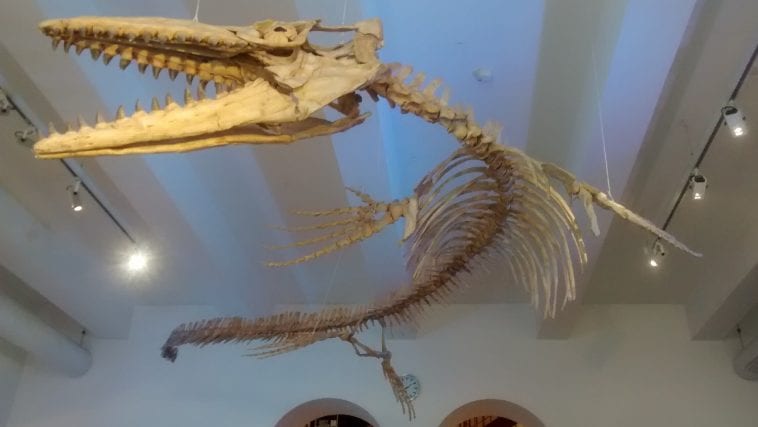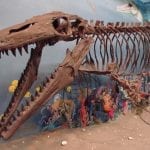Essay by Ethan Hinesley (Teacher: Perry Fishbaugh)
Imagine an ocean scene around 6000 years ago. Light shimmers in the depths, a cool silence fills the surroundings, and nothing seems to stir. Then, a group of gigantic sea turtles comes into focus. Through the dark blue water, they appear as massive, mysterious forms. Suddenly, from the abyssal background, another equally vast creature seems to have arrived from out of nowhere. Unlike the turtles, it’s long, snake-like, and sinister to behold. It instantly slashes through the sea turtle ranks, and its elongated jaws crush down on a helpless turtle’s shell.
What is it? It is the mighty Mosasaurus; one of the top predators of the ancient seas, and a foe to be avoided. Yet, aside from the beast’s fame and prowess, what actual information can be gleaned from studying this extinct animal? Perhaps there is no better way to learn about the Mosasaurus than through a look at the reptile’s fossil facts, history, description, and habits.
Fossil Discovery
The mosasaur provides an interesting study concerning its fossils and common history. Mosasaur bones have been uncovered around the globe, so it’s not hard to understand why they have received so much attention and fame. They have been unearthed in most of the US states, including a significant discovery in South Dakota.
Many hundreds, or even thousands of years ago, the native Americans supposedly found the remains of mosasaur in the Midwest and attributed supernatural powers to the beast. Years later, in 1764, the first documentation of the mosasaur occurred when some skeletal remains were discovered along the Meuse River in Holland. The dinosaur’s scientific name, m. hoffmanni, is attributed to scientist C. K. Hoffman, a man who studied the mosasaur bones.
According to analysis, the Mosasaurus genus is from the late Cretaceous period, a designation concerning certain sections of the geological column where their bones are found. Evolutionists believe the mosasaur lived around 98 to 65 million years ago.
Along with this assumption, Darwinian scientists propose that the four different types of Mosasaurus show four evolutionary stages of the animal. They further endeavor to back up this claim by pointing to the fact that, since mosasaur bones have been found in certain places of the geological column based on their exact type, this, therefore, proves the dinosaur must have morphed into different forms over the years.
In reality, this lends evidence to the global flood described in the book of Genesis, which, no doubt, spread the remains of the Mosasaurus throughout differing layers. As an article featured on Answers in Genesis puts it,
Neither segregation within the geological column nor evidence of distinctive habitats proves the varieties [of mosasaur] evolved sequentially over 27 million years. They [the evolutionists] have not observed “incremental stages of major evolutionary transitions within a single animal lineage. . .in the fossil record.”
In reality, creationists realize that the Mosasaurus was specifically created by God on the fifth day of creation about 6000 years ago. While it is possible that some microevolutionary processes, like change in climate, etc., prompted some variation within the common kind, it is certain that there were none of the substantial alterations proposed by evolutionists. Without a doubt, the mosasaur is a testament to God’s creative authority.
Design Features
So, what exactly is a Mosasaurus? Well, mosasaurs resembled large sea snakes and had paddle-shaped tails and two pairs of relatively weak flippers. Fossils found have shown creatures around 10 feet long, though they are thought to have reached up to 50 ft. Adults potentially grew to 15 tons. They possessed dark scales and dagger-like teeth. Mosasaurs are thought to have given birth to live young.
Aside from their overall appearance, the Mosasaurus displayed fearsome habits. Mosasaurs used their teeth to puncture their prey, like the soft shells of turtles. They could unhinge their lower jaw to swallow large prey. Mosasaurs did not chew.
Conclusion
Mosasaurs were indeed intriguing aspects of God’s creation. From their formidable habits to their general appearance, these dinosaurs glorify their Designer, not evolution. Even though we can’t travel back in time to see them, they are still an intriguing study.
Works Cited
Fulbright, Jeannie K. Exploring Creation with Zoology 2: Swimming Creatures of the Fifth Day Apologia Educational Ministries, Inc., 2006.
Extinctanimals.org: Mosasaurus






